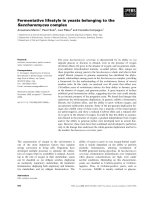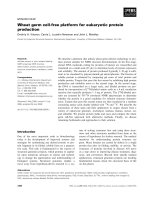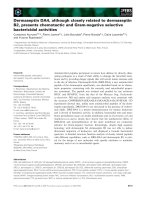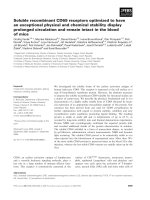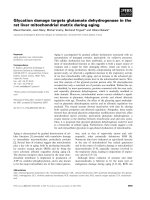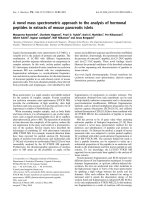Báo cáo khoa học: "Mixed germ cell tumor metastatic to the skin: Case report and literature review" pptx
Bạn đang xem bản rút gọn của tài liệu. Xem và tải ngay bản đầy đủ của tài liệu tại đây (850.72 KB, 4 trang )
CAS E REP O R T Open Access
Mixed germ cell tumor metastatic to the skin:
Case report and literature review
Kun-Lung Chuang
1,2
, Chaung-Chi Liaw
3
, Shir Hwa Ueng
4
, Shuen-Kuei Liao
2
, See-Tong Pang
1
, Ying-Hsu Chang
1
,
Heng-Chang Chuang
1
, Cheng-Keng Chuang
1,2*
Abstract
Background: Testicular cancer is the most common cancer for males aged 15~35 years old. The initial
presentation is typically an asymptomatic enlarged testicle. The retroperitoneum is the most common metastatic
area. Other metastatic sites include the lung, liver, brain, adrenal glands, gastrointestinal tract and spleen. Skin
metastasis is a rare event and frequently associated with poor prognosis.
Case presentation: A 19-year old male was diagnosed testicular mixed germ cell tumor with initial presentation of
cutaneous metastasis at scalp and upper abdomen. After radical orchiectomy and four courses of cisplatin-based
chemotherapy, the scalp and upper abdominal lesions regressed completely. The size of lung metastases remained
unchanged.
Conclusions: For advanced stage testicular cancer, cisplatin-based chemotherapy is still effective to achieve partial
response.
Background
Cutaneous manifestation of an internal malignancy is
rare, with an incidence of 2.9-9%[1,2]. The frequencies
of skin metastases in females are 69% for breast cancer,
9% for colon cancer, and 5% for melanoma. In males
the frequencies of cutaneous metastases are 24% for
lung cancer, 19% for colon c ancer, and 13% for mela-
noma [3,4] Cutaneous metastases of the genitourinary
tract tumors have been associated with cancers of the
prostate [5], bladder [6], and kidney [7]. This report
describes a case of testicular germ cell tumor with skin
metastases at the initial presentation.
Case Presentation
A 19-year-old male was in good health conditions
before admission. He suffered progressively enlarging
upper abdominal skin lesions and scalp nodules for 3
months(fig.1,2).Thesenoduleswerestonyhardwith
mild bleeding. Excisional biopsies of these two anatomi-
cal diverse origins reveal ed metast atic germ cell tumors.
An example of H&E stained section from the abdominal
lesion is shown in fig. 3. Immunohistochemical st a i n i n g
on the other area of the section reveals some b-HCG
positive syniotrophoblastic cells in the sea of other
tumor cells (fig. 4). Initial b-HCG and AFP levels in
the blood were 2,630 mIU/ml and 396 n g/ml, respec-
tively. Testicle ultrasonography disclosed two small
heterogenous masses in the upper and lower poles o f
the left testis. By abdominal computed tomography, no
obvious retroperitoneal lymph nodes were detected,
but several metastatic nodules sized from 1 ~3 cm
were seen i n the l eft lower lung. Left radical orchiect-
omy was therefore performed. Pathology revealed that
tumor cells were c omposed of an admixture of cystic
lesions lined by squamous epithelia and containi ng
keratin, pseudostratified columnar epithelium with
goblet cells, primitive cuboidal cells, with a myxoid
reticular and solid pattern, Schiller Duval bodies, hya-
line globules and nests of undifferentiated epithelial
cells. The primary tumor was confined in the testis.
The patient underwent four courses of chemotherapy
with PEB (cisplatin, etoposide, bleomycin). Complete
response for the scalp lesions was achieved, while the
lung metastasis remained stable four years after sur-
gery. The two tumor markers initially detected became
undetectable.
* Correspondence:
1
Division of Uro-oncology, Department of Surgery, Chang Gung Memorial
Hospital, Taoyuan, Taiwan
Chuang et al . World Journal of Surgical Oncology 2010, 8:21
/>WORLD JOURNAL OF
SURGICAL ONCOLOGY
© 2010 Chuang et al; licensee BioMed Central Ltd. This is an Open Access article distr ibut ed under the terms of the Creative Commons
Attribution License (http:// creativecommons.org/licenses/by/2.0), which permits u nrestricted use, distribution, and reproduction in
any medium, provided the original work is properly cited.
Figure 1 Two upper abdominal cutaneuos nodules.
Figure 2 Multiple nodules at the scalp showing ulceration and mild bleeding on the top of each nodule.
Chuang et al . World Journal of Surgical Oncology 2010, 8:21
/>Page 2 of 4
Figure 3 H&E stained section of the skin revealed the ulcerated skin tumor involving the dermis and subcutis. A tubular papillary
pattern was identified at low magnification. (×20).
Figure 4 Several syncytiotrophoblastic cells formed in the sea of other tumor cells are positive for b-HCG. (×400).
Chuang et al . World Journal of Surgical Oncology 2010, 8:21
/>Page 3 of 4
Discussion
Cutaneous metastases originating fr om a solid organ are
roughly 2 % [1]. Most of t he cutaneous metastases were
noted by a prior cance diagnosis; While only 8% of
cases represented the first indication of an internal
malignancy [8]. The most common sites of metastastatic
disease from urologic malignancies are lymph nodes,
bone, lung, and liver [9]. The incidence of cutaneous
metastasis from all urologic malignancies is 1.1% to
2.5% [8]. The relative incidences of metastasis to the
skin among gentitourinary cancers are 3.4% to 4.0% for
renal cell carcinoma, 0.84% to 3.6% for transitional c ell
carcinoma, 0.4% for germ cell tumors, and 0.36% to
0.7% for prostate adenocarcinoma[9].
Testicular mixed germ cell tumors are common, com-
prising roughly 33% of all testicular tumors. The reason
for such a high incidence of testicular mixed germ-cell
tumors is because germ cells in the testes are t otipotent
and can un dergo either trophoblast or somatic differen-
tiation. Among all the subtypes of testicular germ cell
tumor, choriocarcinoma is the most aggressive with
highly metastatic potential [10].
The cutaneous metastasis as the first sign of meta-
static choriocarcinoma could have been ei ther an occult
or a slow growing primary testis germ cell tumor
[11-15]. Cutaneous metastasis of the genitourinary
malignant neoplasm is often related to advanced local
extension, disseminated metastasis and poor prognosis.
In this case, no retroperitoneal lymph node metastasis
was observed.
According to the International Germ Cell Consensus
Prognosis for Testicular Cancer[16], the 5-year progres-
sion-freesurvivalrateis41%fornon-seminomaorigin
and non-pulmonary visceral metastasis. The present
case was classified as poor prognostic. After four courses
of PEB regimen (cisplatin, etoposide, bleomycin), the
scalp and abdominal lesions achieved complete response
but the lung metastasis remained stable in size.
Conclusion
The skin is an uncommon site for testicular germ cell
metastasis. A cutaneous lesion can be difficult to be dif-
ferentiate d from a primary cutaneous neoplasm. Exci-
sional biopsy is required for definite diagnosis. For
advanced stage testicular cancer, cisplatin-based che-
motherapy is still effective to achieve biochemical
remission.
Consent
Written informed consent was obtained from the patient
for publication of this case report and accompanying
images. A copy of the written consent is available for
review by the Editor-in-Chief of this journal.
Author details
1
Division of Uro-oncology, Department of Surgery, Chang Gung Memorial
Hospital, Taoyuan, Taiwan.
2
Graduate Institute of Clinical Medical Sciences,
Chang Gung University, Taoyuan, Taiwan.
3
Division of Medical Oncology,
Chang Gung Memorial Hospital, Taoyuan, Taiwan.
4
Department of Pathology,
Chang Gung Memorial Hospital, Taoyuan, Taiwan.
Authors’ contributions
KLC was the first author, responsible for the conception and design for the
manuscript, the clinical work, the search for the literature, and the editing
work.
SHU was responsible for the histopathological work. STP, HCC, YHC and CCL
helped in the clinical work as well as the literature review. STP and SKL were
responsible for editorship of the manuscript. CKC is the head of the
department who supervised all the steps of the work.
Competing interests
The authors declare that they have no competing interests with people or
organizations in preparation of this study.
Received: 4 January 2010 Accepted: 23 March 2010
Published: 23 March 2010
References
1. Spencer PS, Helm TN: Skin metastases in cancer patients. Cutis 1987,
39:119-21.
2. Mueler TJ, Wu H, Geenberg RE, Hudes G, Topham N, Lessin SR, Uzzo RG:
Cutaneous metastases from genitourinary malignancies. Urology 2004,
63:1021-6.
3. Healy P, Malott K, Chalet M: Cancers metastatic to the skin. Cancer of the
skin Philadelphia: W.B. SaundersFriedman RJ, Rigel DS, Kopf AW, Harris MN,
Baker D 1991, 347-64.
4. Brash DE: Cancer of the skin. Cancer: Principles and practice of oncology
Philadelphia: Lippincott-RavenDeVita VT, Rosenberg, SA, Hellman S, 5 1997,
1913-50.
5. Aria K, Kawashima T, Shimizu H: Cutaneous metastasis of prostate
carcinoma. Clin Exp Dermatol 2002, 27:64-5.
6. Akman Y, Cam K, Kavak A, Alper M: Extensive cutaneous metastasis of
transitional cell carcinoma of the bladder. Int J Urol 2003, 10:103-104.
7. Gurer CK, Karaduman A, Bukulmez G, Sahin S, Ozkaya O, Erkan I: Renal cell
carcinoma with skin metastasis. J Eur Acad Dermatol Venereol 2004,
18:386-7.
8. Saeed S, Keehn CA, Morgan MB: Cutaneous metatasis: a clinical,
pathological and immunohistochemical appraisal. J Cutan Pathol 2004,
31:419-30.
9. Block CA, Dahmoush L, Konety BR: Cutaneous metatases from transitional
cell carcinoma of the bladder. JUrol 2006, 67(846):e15-7.
10. Tinkle LL, Graham BS, Spillane TJ, Barr RJ: Testicular choriocarcinoma
metastatic to the skin: an additional case and literature review. Cutis
2001, 67:117-20.
11. Kiriyama T, Yoshida O: A review of the cases of testicular tumors reported
in the annual of pathological autopsy cases in Japan. Hinyokika Kiyo 1983,
29:155-68.
12. Bredael JJ, Vugrin D, Whitmore WF Jr: Autopsy findings in 154 patients
with germ cell tumors of the testis. Cancer 1982, 50:548-51.
13. Figurin KM: Effect of retroperitoneal lymphadenectomy on late
therapeutic results in testicular tumors. Vopr Onkol 1981, 27:70-3.
14. Wettlaufer JN: Stage III germinal testis tumors: aggressive approach. J
Urol 1976, 116:593-7.
15. Xinhua Chen, Linjie Xu, Xinmei Chen, Xiaodong Teng, Shusen Zheng:
Testicular choriocarcinoma metastatic to skin and multiple organs. Two
case reports and review of literature. J Cutan Pathol 2009, 37(4):486-90.
16. International Germ Cell Consensus Classification: A prognostic factor based
staging system for metastatic germ cell cancers. J Clin Oncol 1997,
15:594-603.
doi:10.1186/1477-7819-8-21
Cite this article as: Chuang et al.: Mixed germ cell tumor metastatic to
the skin: Case report and literature review. World Journal of Surgical
Oncology 2010 8:21.
Chuang et al . World Journal of Surgical Oncology 2010, 8:21
/>Page 4 of 4


